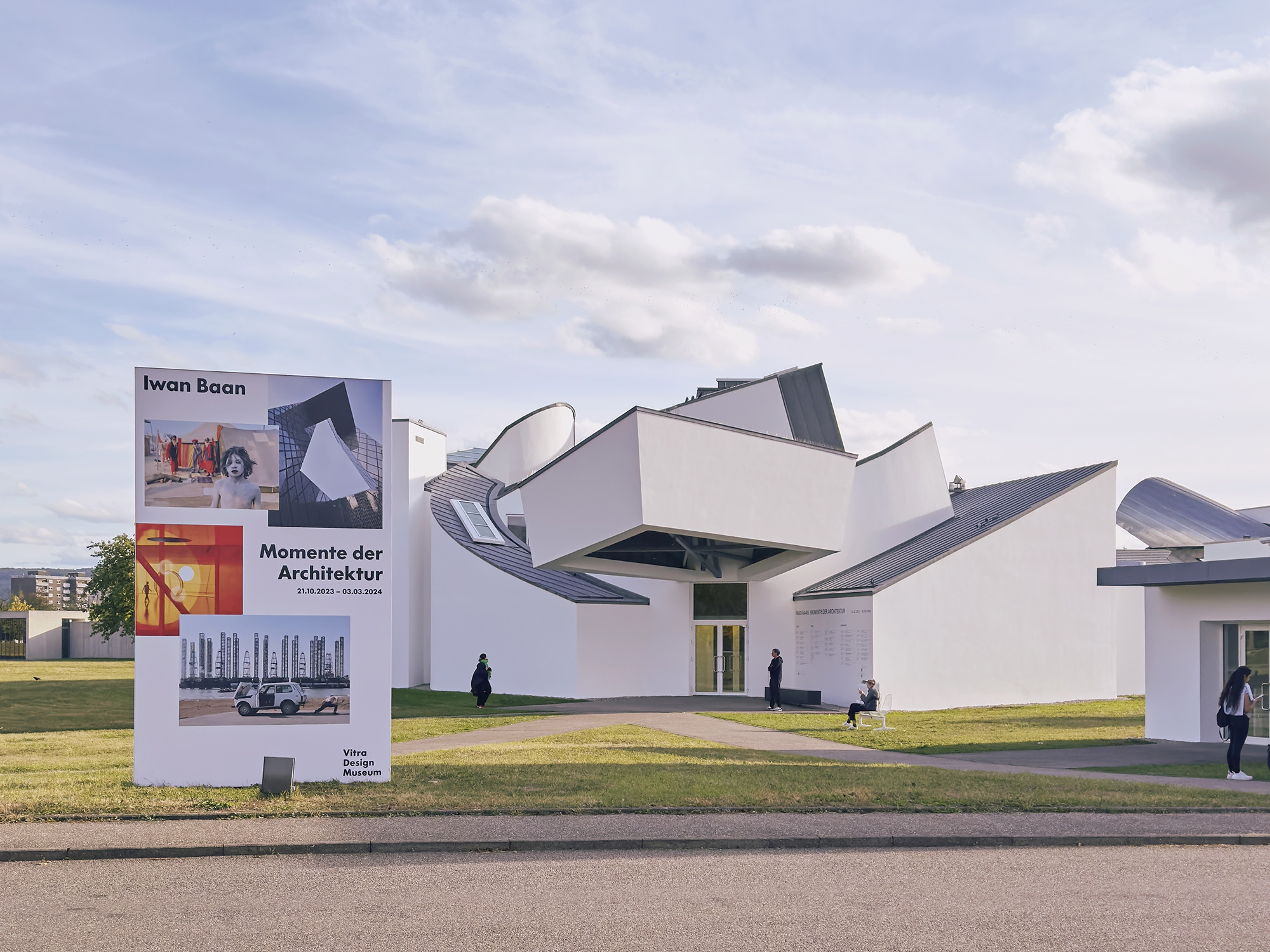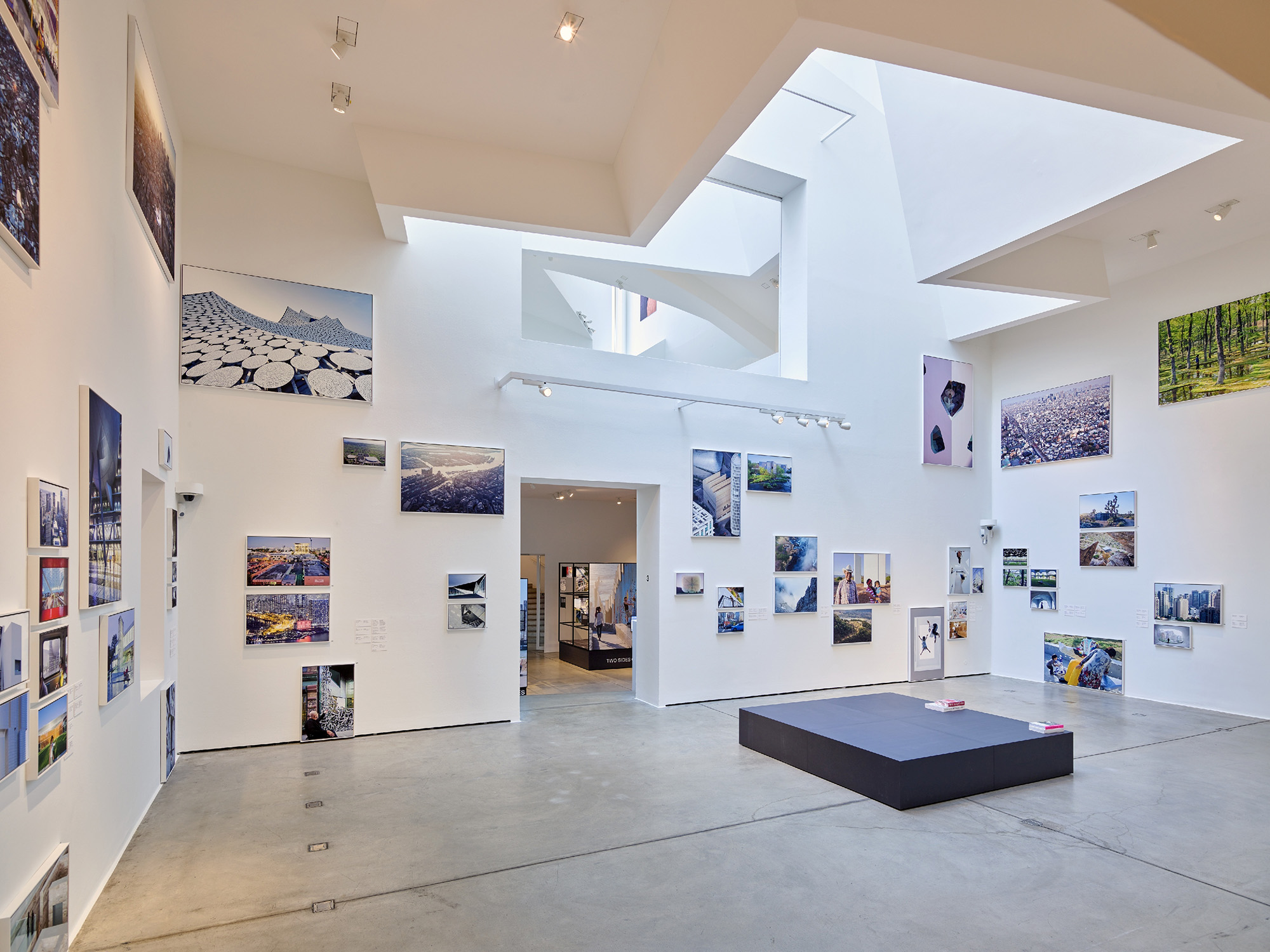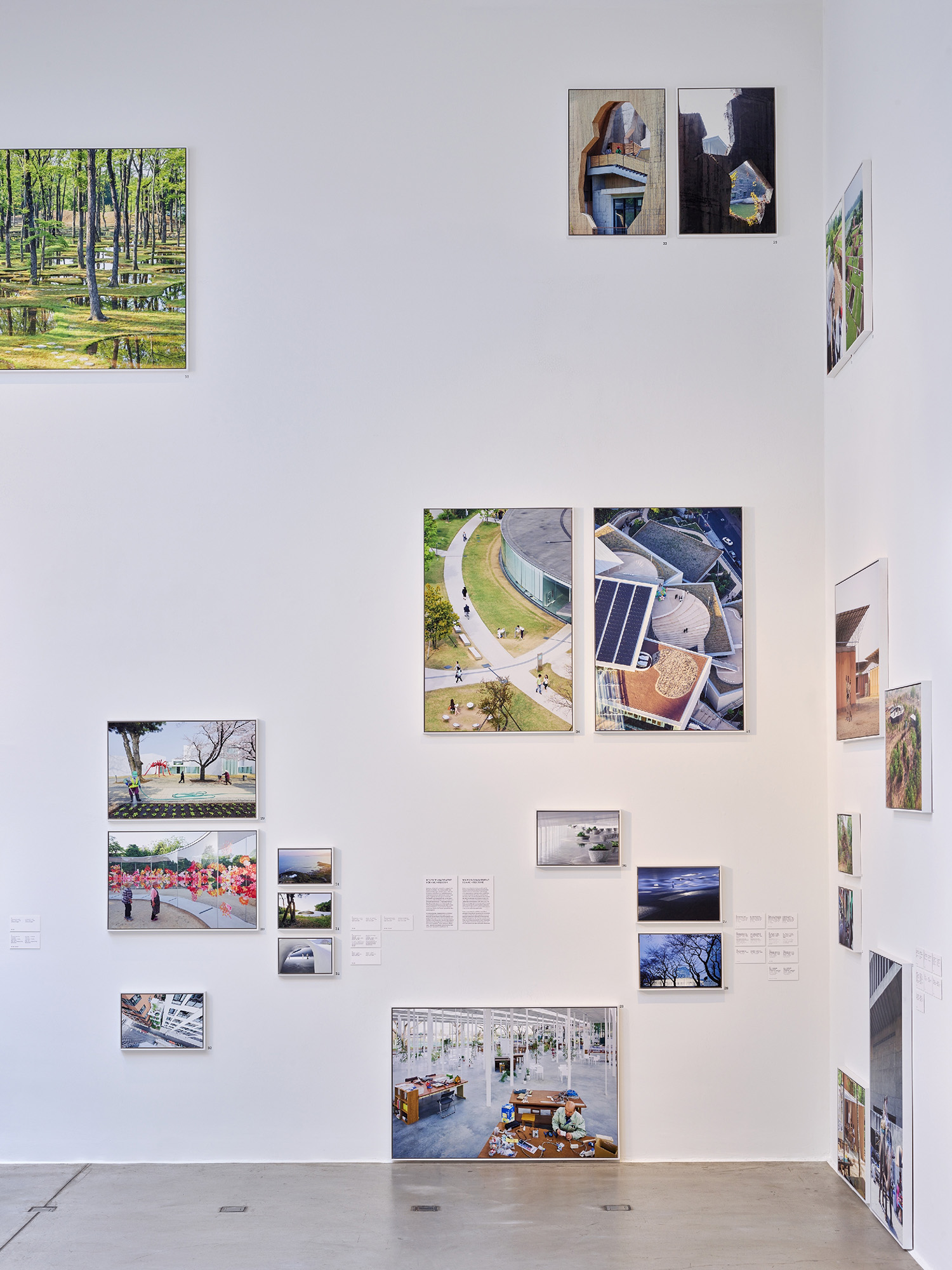A Vitra exhibition & book showcase Iwan Baan’s architectural
moments
The chances are that when looking at a photograph of the latest grand architectural project to have opened anywhere in the world, the name under the image reads Iwan Baan. The Dutch photographer is the go-to creative for architects & starchitects the world over & with a recent exhibition at Vitra Design Museum with an extensive published catalogue, James Haynes considers the images Baan creates.
As we cascade into a pixelated world navigable through panning,
scrolling, and zooming, photographs have seized our attention, dominating the
means by which we consume the built environment. They facilitate exploration,
discourse, and debate, can frame engagement, and craft the narrative of
architecture. Carefully controlled images can demand specific readings through
the placement of figures, and arrangement of details and perspectives. Like a play,
what we see is a choreographed version of reality.
The go-to creative for architects – and starchitects – the world over is Iwan Baan, a Dutch photographer extolled for capturing moments in the built environment. His international work was recently explored in an exhibition at the Frank Gehry-designed Vitra Design Museum in Weil am Rhein, Germany, alongside an accompanying catalogue with 600 of the photographer’s images.
![]()
![]()
![]()
The exhibition, Moments in Architecture, embraced Baan’s polemic approach, with a hang which dispelled the refined lines that marshal arrangements of photography in many galleries. There is a messiness and sense of chaos, with an implied ambivalence to the placement of works, though a result of great attention and care in the curation. Images sit flush to each other, were arranged at different heights, and were presented within forms that break the typical two-dimensional viewing plane.
Although challenging the viewer’s ability to read and understand a single image, this deconstructed language of curation is fresh and felt apt, offering a jumbled juxtaposition to the defined resolution within Baan’s photographic compositions. As an exercise in crafting an environment supportive of a specific kind of representation, this clever unsettling is inimitable, riffing off Baan’s approach and interest in the importance of subjects within fields of concrete matter.
![]()
![]()
![]()
A series of images catalogued under the label of China – sensibly, but perhaps a little prosaically – exemplifies Baan’s interest in happenings and undefined moments in the life that occurs around the spaces architects have designed. Beginning with a display of OMA’s CCTV building – Baan’s first major project, a foray initiated by a chance encounter with OMA co-founder Rem Koolhaas – the photographer’s interest in the relationship between people and space is inescapable, his images capturing the process of the building’s construction, as the architectural elements come together, rather than its pristine finished state.
Through this, a layer of architecture often concealed in glossy representations has been made raw. His photographic focus is not on a perfect framing, the detailed meeting of materials, or an artful manipulation of light, instead, Baan captures the folds embedded within its creation – the lives of those that construct it, the material beneath the surface, the coordinated chaos responsible for bringing a building to life.
![]()
![]()
![]()
figs.vii-ix
Ever the internationalist, perhaps mimicking the bold un-bordered ambitions of the many starchitects he often works for, Baan’s portfolio rejects locality. Presented across the exhibition of well-selected images, which provide a real sum of his oeuvre, are works located in China, Italy, the United States, and Burkina Faso – to name a few. Reflecting context, an evident pre-occupation of Baan, there is no stylistic concurrence between locations, though his imagery undoubtedly has a brand identity. This includes aerial views, which perhaps are the most repeated calling card – for which Baan favours the use of a helicopter, perhaps appropriate given the unapologetic environmental impact of the buildings he records.
Regardless, Baan’s photography proffers a unique snapshot, situating the built object into the urban grain – a rarity in the work of many of his contemporaries. Photographs of the Heydar Aliyev Centre by Zara Hadid Architects (2013) and Za Kōenji Public Theatre by Toyo Ito & Associates (2009) exemplify this awareness of urban context, illustrating the importance of positioning within a backdrop to the success of any piece of architecture.
![]()
![]()
![]()
figs.x-xii
Although varied, the biggest anomaly in Baan’s extended portfolio is his work with architect Diébédo Francis Kéré. Despite much of his photography stemming from expressions of controlled freedom – achieved through the presentation of highly-refined randomness – images capturing Kéré’s work feel more programmed, framed, and obviously deliberate, carrying more of a sense of Baan’s interest in architecture’s ability to shape the environment in which it sits. Images of Kéré’s buildings portray the intimate relationship between architecture, light, and shadows, allowing for a more explicit presentation of Baan’s ability behind the camera.
This appears to show a desire to record a different kind of architecture, one removed from the language of the starchitect. Alongside Kéré, Baan captures a vernacular indebted to an architecture that which is described on wall text as: “naturally evolving and adapting spaces that are as varied as the needs of their inhabitants.” The Vitra exhibition illustrated this approach well, drawing on a different mode of presentation which allowed the viewer to get physically closer to the image and its inhabitants, a shift from the scattered arrangement of images and high-resolution projections throughout the rooms. The display of Kéré’s work invited the viewer to lie down on one of the black plinths and look up at a screen suspended above, offering a feeling of total absorption.
![]()
![]()
![]()
figs.xiii-xv
Given the depth of his work, any commentary on Baan ultimately only scratches the surface. The exhibition and accompanying publication make a respected attempt to cover the range, through the harnessing of novel modes of representation and the sheer scale of the book. Neither claims to portray a full comprehension of Baan’s career, but there is real attempt to display what the Director of Vitra Design Museum, Mateo Kries, states in his text in the book: “an encyclopaedic panorama of global architecture in the early twenty-first century, of its urban and social context, and of the people that inhabit or use it.” In presenting the work across four themes – China, Perspectives, Cities and Continuities – and from the camera of a single author, an insightful snapshot is revealed.
As a photographer of the contemporary built environment, Iwan Baan is unquestionably a significant figure. Through his work, Baan looks to unsettle what it is to capture a moment in architecture, instead seeking to present the built environment as contextual to the life it supports. In producing images that present a narrative, rather than clean lines, sterile landscapes, and unoccupied perfection, Baan illustrates the power of architecture in facilitating chance encounters and allowing life to occur within urban forms.
For those unfamiliar with Baan’s work, an embrace of his ability to frame architecture, be that through his numerous publications or Moments in Architecture – which having now completed its presentation at Vitra is set to tour internationally – offers a unique opportunity to dispel the too often lauded and cleansed perfection of architectural photography. Baan offers an insight into beauty within chaos, the power of chance, and a need for architecture that is embracive and dependent upon the people who use it.
![]()
![]()
![]()
figs.xvi-xviii
The go-to creative for architects – and starchitects – the world over is Iwan Baan, a Dutch photographer extolled for capturing moments in the built environment. His international work was recently explored in an exhibition at the Frank Gehry-designed Vitra Design Museum in Weil am Rhein, Germany, alongside an accompanying catalogue with 600 of the photographer’s images.



figs.i-iii
The exhibition, Moments in Architecture, embraced Baan’s polemic approach, with a hang which dispelled the refined lines that marshal arrangements of photography in many galleries. There is a messiness and sense of chaos, with an implied ambivalence to the placement of works, though a result of great attention and care in the curation. Images sit flush to each other, were arranged at different heights, and were presented within forms that break the typical two-dimensional viewing plane.
Although challenging the viewer’s ability to read and understand a single image, this deconstructed language of curation is fresh and felt apt, offering a jumbled juxtaposition to the defined resolution within Baan’s photographic compositions. As an exercise in crafting an environment supportive of a specific kind of representation, this clever unsettling is inimitable, riffing off Baan’s approach and interest in the importance of subjects within fields of concrete matter.



figs.iv-vi
A series of images catalogued under the label of China – sensibly, but perhaps a little prosaically – exemplifies Baan’s interest in happenings and undefined moments in the life that occurs around the spaces architects have designed. Beginning with a display of OMA’s CCTV building – Baan’s first major project, a foray initiated by a chance encounter with OMA co-founder Rem Koolhaas – the photographer’s interest in the relationship between people and space is inescapable, his images capturing the process of the building’s construction, as the architectural elements come together, rather than its pristine finished state.
Through this, a layer of architecture often concealed in glossy representations has been made raw. His photographic focus is not on a perfect framing, the detailed meeting of materials, or an artful manipulation of light, instead, Baan captures the folds embedded within its creation – the lives of those that construct it, the material beneath the surface, the coordinated chaos responsible for bringing a building to life.



figs.vii-ix
Ever the internationalist, perhaps mimicking the bold un-bordered ambitions of the many starchitects he often works for, Baan’s portfolio rejects locality. Presented across the exhibition of well-selected images, which provide a real sum of his oeuvre, are works located in China, Italy, the United States, and Burkina Faso – to name a few. Reflecting context, an evident pre-occupation of Baan, there is no stylistic concurrence between locations, though his imagery undoubtedly has a brand identity. This includes aerial views, which perhaps are the most repeated calling card – for which Baan favours the use of a helicopter, perhaps appropriate given the unapologetic environmental impact of the buildings he records.
Regardless, Baan’s photography proffers a unique snapshot, situating the built object into the urban grain – a rarity in the work of many of his contemporaries. Photographs of the Heydar Aliyev Centre by Zara Hadid Architects (2013) and Za Kōenji Public Theatre by Toyo Ito & Associates (2009) exemplify this awareness of urban context, illustrating the importance of positioning within a backdrop to the success of any piece of architecture.



figs.x-xii
Although varied, the biggest anomaly in Baan’s extended portfolio is his work with architect Diébédo Francis Kéré. Despite much of his photography stemming from expressions of controlled freedom – achieved through the presentation of highly-refined randomness – images capturing Kéré’s work feel more programmed, framed, and obviously deliberate, carrying more of a sense of Baan’s interest in architecture’s ability to shape the environment in which it sits. Images of Kéré’s buildings portray the intimate relationship between architecture, light, and shadows, allowing for a more explicit presentation of Baan’s ability behind the camera.
This appears to show a desire to record a different kind of architecture, one removed from the language of the starchitect. Alongside Kéré, Baan captures a vernacular indebted to an architecture that which is described on wall text as: “naturally evolving and adapting spaces that are as varied as the needs of their inhabitants.” The Vitra exhibition illustrated this approach well, drawing on a different mode of presentation which allowed the viewer to get physically closer to the image and its inhabitants, a shift from the scattered arrangement of images and high-resolution projections throughout the rooms. The display of Kéré’s work invited the viewer to lie down on one of the black plinths and look up at a screen suspended above, offering a feeling of total absorption.



figs.xiii-xv
Given the depth of his work, any commentary on Baan ultimately only scratches the surface. The exhibition and accompanying publication make a respected attempt to cover the range, through the harnessing of novel modes of representation and the sheer scale of the book. Neither claims to portray a full comprehension of Baan’s career, but there is real attempt to display what the Director of Vitra Design Museum, Mateo Kries, states in his text in the book: “an encyclopaedic panorama of global architecture in the early twenty-first century, of its urban and social context, and of the people that inhabit or use it.” In presenting the work across four themes – China, Perspectives, Cities and Continuities – and from the camera of a single author, an insightful snapshot is revealed.
As a photographer of the contemporary built environment, Iwan Baan is unquestionably a significant figure. Through his work, Baan looks to unsettle what it is to capture a moment in architecture, instead seeking to present the built environment as contextual to the life it supports. In producing images that present a narrative, rather than clean lines, sterile landscapes, and unoccupied perfection, Baan illustrates the power of architecture in facilitating chance encounters and allowing life to occur within urban forms.
For those unfamiliar with Baan’s work, an embrace of his ability to frame architecture, be that through his numerous publications or Moments in Architecture – which having now completed its presentation at Vitra is set to tour internationally – offers a unique opportunity to dispel the too often lauded and cleansed perfection of architectural photography. Baan offers an insight into beauty within chaos, the power of chance, and a need for architecture that is embracive and dependent upon the people who use it.



figs.xvi-xviii
Iwan Baan is known primarily for images that
narrate the life & interactions that occur within architecture. Born in
1975, Iwan grew up outside Amsterdam, studied at the Royal Academy of Art in
The Hague & worked in publishing and documentary photography in New York &
Europe. Baan followed his interest in documentary photography, before narrowing
his focus to record the various ways in which individuals, communities &
societies create, and interact within their built environment.
With no formal training in architecture, his
perspective mirrors the questions & perspectives of the everyday
individuals who give meaning & context to the architecture & spaces
that surround us, & this artistic approach has given matters of
architecture an approachable & accessible voice.
As the inaugural recipient of the Julius Shulman
award for photography, architects such as Rem Koolhaas, Herzog & de Meuron,
Zaha Hadid, Diller Scofidio & Renfro, Toyo Ito, SANAA & Morphosis turn
to Baan to give their work a sense of place and narrative within their
environments. Alongside his architecture commissions, Iwan has collaborated on
several successful book projects such as Insular Insight: Where Art and
Architecture Conspire with Nature, Torre David: Informal Vertical
Communities and Brasilia & Chandigarh – Living With Modernity.
Baan’s work also appears on the pages of architecture, design & lifestyle
publications such as The Wall Street Journal, The New York Times, Architectural
Record, Domus, Abitare & Architectural Digest.
www.iwan.com
James Haynes graduated from the Edinburgh School of
Architecture & Landscape Architecture (ESALA) in 2023 & currently works
as an architectural assistant for the artist Do Ho Suh. James has a keen
interest in architectural writing & research, which he has found an
opportunity for expression through support from the Carnegie Trust for the
Universities of Scotland & involvement with several publications: the
RIBAJ, RIAS Quarterly, Architecture Ireland & others. Upon graduating,
James received the ESALA MA Architecture Prize for best graduating student and
his thesis project, A Tober: An Architecture of Resilience and Joy,
received the ESALA nomination for the RIBA Bronze Medal.
www.jameshaynes.co.uk
www.jameshaynes.co.uk
purchaseIwan Baan:
Moments in Architecture exhibited at the Vitra Design Museum & will soon travel internationally.
An exhibition catalogue with the same title is published by the museum, with further details available from their shop: www.shop.design-museum.de/en/products/iwan-baan-moments-in-architecture
images
fig.i Exterior view Vitra Design Museum “Iwan Baan: Moments in Architecture” © Vitra Design Museum Photo: Mark Niedermann
figs.ii,iv,v,x,xiii,xv,xviii Installation view “Iwan Baan: Moments in Architecture” © Vitra Design Museum Photo: Mark Niedermann
fig.iii Iwan Baan, Baku, Azerbaijan, 2011.
© Iwan Baan
fig.vi Iwan Baan, House NA, Tokyo, Japan, 2011, Architecture: Sou Fujimoto Architects.
© Iwan Baan
figs.vii,viii Iwan Baan, CCTV Headquarters, Beijing, China, 2011, designed by OMA © OMA © Iwan Baan
fig.ix Iwan Baan, Tiébélé, Burkina Faso, 2021.
© Iwan Baan
fig.xi Iwan Baan, National Taichung Theatre, Taiwan, 2016, Architecture: Toyo Ito & Associates, Architects.
© Iwan Baan
fig.xii Iwan Baan, Las Vegas, USA, 2022.
© Iwan Baan
fig.xiv Iwan Baan, Gando Secondary School, Burkina Faso, 2021, Architecture: Kéré Architecture.
© Iwan Baan
fig.xvi Portrait Iwan Baan © Vitra Design Museum Photo: Mark Niedermann
fig.xvii Iwan Baan: Moments in Architecture: Works 2005-Now, published by Vitra Design Museum.
publication date
15 March 2024
tags
Architectural photography, Iwan Baan, Construction, CCTV Building, China, Frank Gehry, James Haynes, Kéré Architecture, Mateo Kries, Rem Koolhaas, OMA, Photography, Starchitects, Toyo Ito & Associates, Vitra Design Museum, Zaha Hadid Architects
An exhibition catalogue with the same title is published by the museum, with further details available from their shop: www.shop.design-museum.de/en/products/iwan-baan-moments-in-architecture


